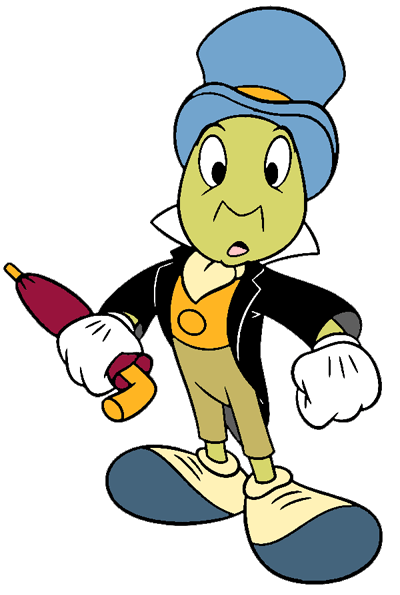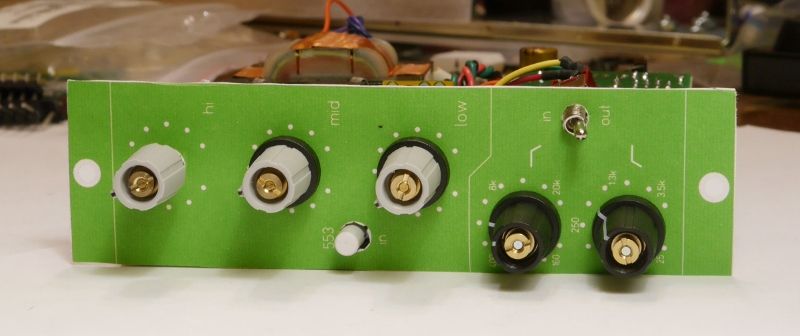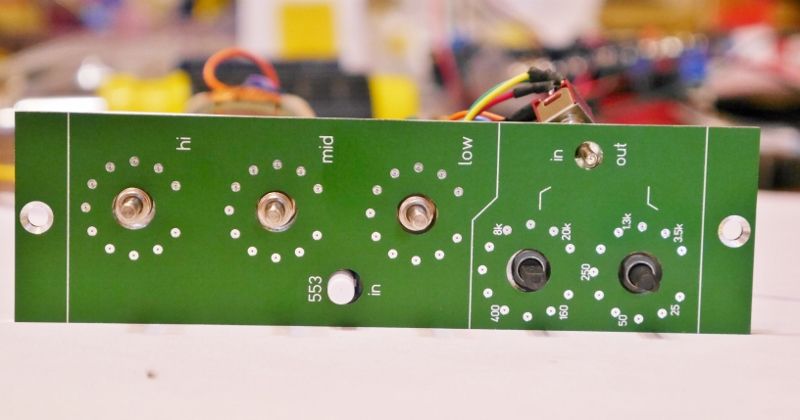EQ Project: API 553 and Harrison Filters in 500 series
Jan 24, 2016 15:58:34 GMT -6
dandeurloo, tonycamphd, and 12 more like this
Post by krcwell on Jan 24, 2016 15:58:34 GMT -6
I finally have a working prototype, so might as well share with the group!
Background: I've been working on a simple 12-16 channel 500 series based console for a little over a year, and am looking for a relatively simple eq design to fill out 4-8 channels of the eq buckets. There are many fantastic DIY 500 series eq kits out there, but at around $400+ a pop, filling 12-16 channels quickly turns in to half a year's mortgage payments. Besides that, the reason I got in to DIY was to figure out how all this stuff works, i.e. Do it myself.
The old API 553 eq seemed to be the simplest design: 3 fixed bands with +/-15db each. The entire eq part of the circuit is 5 resistors, 4 caps, 3 pots, 2 fixed inductors, and 1 switch. From everything I read it was a very musical, "massaging" eq. I had a few JLM audio INX5 boards and figured out I could wire them to work easily with the swinging input topology of the 553 (need to feed both the + and - of a 2520). I also had a few Harrison Ford Filter pcb's sitting around, which if you're unfamiliar are the variable high and low pass filters from the harrison eq. I started playing around with fit on a blank 500 series L bracket, and figured I could mash all this stuff into it pretty easily.
Block Diagram of circuit:
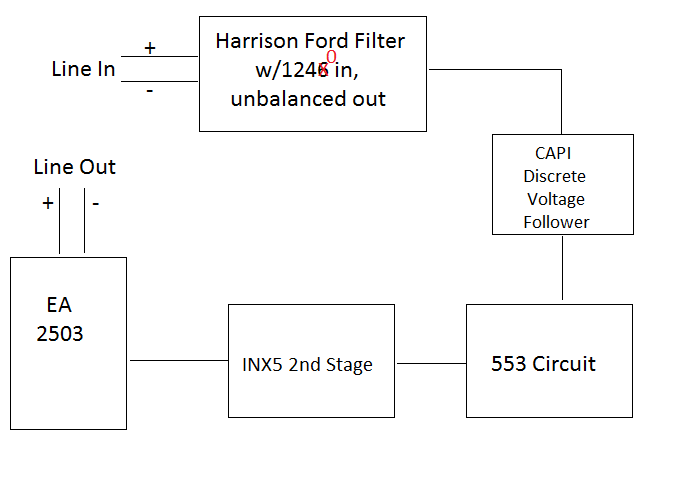
The unit I currently have working is about -6db on the output... I crossed out the 6 and put a 0 for the THAT 124x after I looked at the Harrison Ford Filter schematic again. Normally, the HFF circuit uses an INA134 (0db line receiver) and DRV134 (+6db line driver), so leaving the DRV134 out of the circuit (taking unbalanced) and using a -6db THAT 1246 would leave a -12db signal feeding the discrete voltage follower buffer, not the -6db I was expecting. Putting a 1240 in it's place should keep the overall circuit at unity gain.
I made some pcb's in kicad for the 553 section. Schematic:
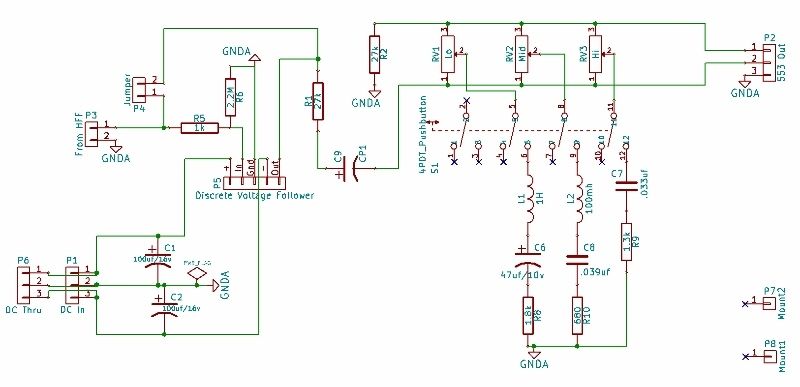
Finished PCB:
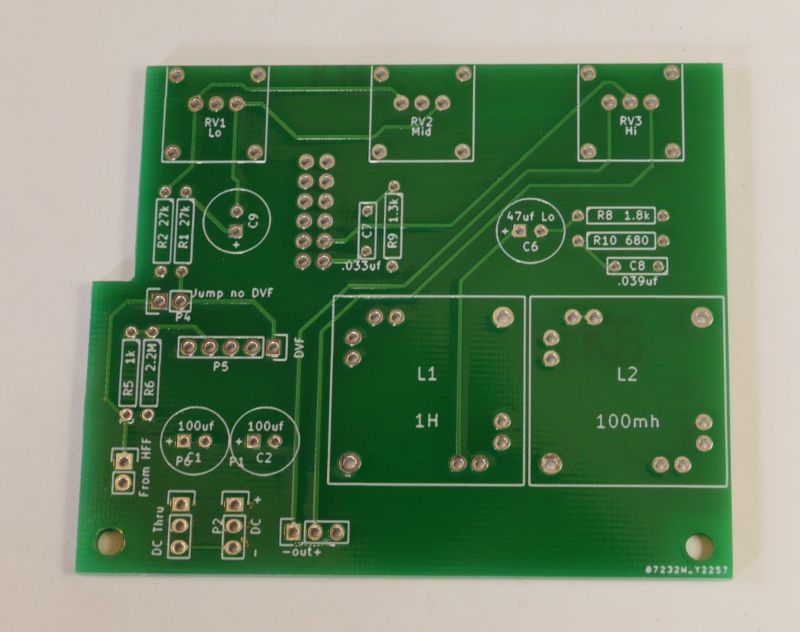
I hand wound some rm8 cores for the inductors. N48 630 for the 1H low, ~1,300 turns, N48 400 for the 100mh mid, ~500 turns. It's really easy when you get in to a rhythm. Just develop some sort of system to keep count. I write down every 100 turns. You WILL screw up if you don't.
Front panel layout sketch:

So now here's where I'm at:


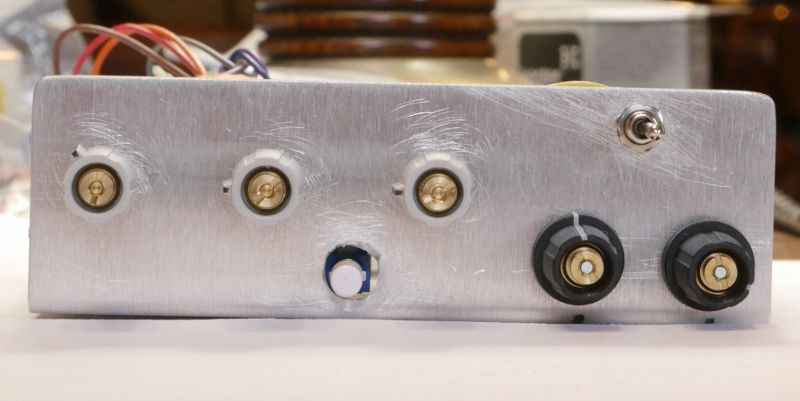

The fact that this monstrosity passed audio today made me super happy. It sounds pretty damn good too (*note: based on very limited usage and doped up on excitement that it worked first try). I ran some vocals from an old session through it for a little while, and the low band is pretty great. Both circuits interact pretty well together.
Like I said earlier, the overall output is -6db. I first tested the primary and secondary windings of the 2503 output transformer, and they were showing correct voltage gain for 1:3 wiring. Then, taking a closer look at the Harrison Ford Filter schem, I realized my error. I have some 1240's on order now. These Harrison filters sound great. I'm gonna start slapping em on any project that has room.
Overall, I'm very happy just that it works. My first truly DIY (for the most part) build.
Thanks,
Keith
Background: I've been working on a simple 12-16 channel 500 series based console for a little over a year, and am looking for a relatively simple eq design to fill out 4-8 channels of the eq buckets. There are many fantastic DIY 500 series eq kits out there, but at around $400+ a pop, filling 12-16 channels quickly turns in to half a year's mortgage payments. Besides that, the reason I got in to DIY was to figure out how all this stuff works, i.e. Do it myself.
The old API 553 eq seemed to be the simplest design: 3 fixed bands with +/-15db each. The entire eq part of the circuit is 5 resistors, 4 caps, 3 pots, 2 fixed inductors, and 1 switch. From everything I read it was a very musical, "massaging" eq. I had a few JLM audio INX5 boards and figured out I could wire them to work easily with the swinging input topology of the 553 (need to feed both the + and - of a 2520). I also had a few Harrison Ford Filter pcb's sitting around, which if you're unfamiliar are the variable high and low pass filters from the harrison eq. I started playing around with fit on a blank 500 series L bracket, and figured I could mash all this stuff into it pretty easily.
Block Diagram of circuit:

The unit I currently have working is about -6db on the output... I crossed out the 6 and put a 0 for the THAT 124x after I looked at the Harrison Ford Filter schematic again. Normally, the HFF circuit uses an INA134 (0db line receiver) and DRV134 (+6db line driver), so leaving the DRV134 out of the circuit (taking unbalanced) and using a -6db THAT 1246 would leave a -12db signal feeding the discrete voltage follower buffer, not the -6db I was expecting. Putting a 1240 in it's place should keep the overall circuit at unity gain.
I made some pcb's in kicad for the 553 section. Schematic:

Finished PCB:

I hand wound some rm8 cores for the inductors. N48 630 for the 1H low, ~1,300 turns, N48 400 for the 100mh mid, ~500 turns. It's really easy when you get in to a rhythm. Just develop some sort of system to keep count. I write down every 100 turns. You WILL screw up if you don't.
Front panel layout sketch:

So now here's where I'm at:




The fact that this monstrosity passed audio today made me super happy. It sounds pretty damn good too (*note: based on very limited usage and doped up on excitement that it worked first try). I ran some vocals from an old session through it for a little while, and the low band is pretty great. Both circuits interact pretty well together.
Like I said earlier, the overall output is -6db. I first tested the primary and secondary windings of the 2503 output transformer, and they were showing correct voltage gain for 1:3 wiring. Then, taking a closer look at the Harrison Ford Filter schem, I realized my error. I have some 1240's on order now. These Harrison filters sound great. I'm gonna start slapping em on any project that has room.
Overall, I'm very happy just that it works. My first truly DIY (for the most part) build.
Thanks,
Keith




